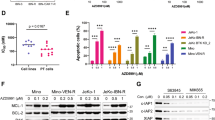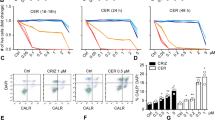Abstract
Revlimid® (Lenalidomide, CC-5013) and CC-4047 are IMiDs® immunomodulatory drugs that have been described as having immunomodulatory properties and anti-tumor activity. Here we report proapoptotic effects of CC-5013 and CC-4047 on tumor cells in a co-culture model of PBMC and tumor cells. CC-5013 and CC-4047 enhanced PBMC activity leading to tumor cell apoptosis in K562/PBMC co-culture model. We also demonstrate that the natural killer (NK) cell population of PBMC was essential in inducing K562 apoptosis. Increases of NK and natural killer T (NKT) cell populations by CC-5013 and CC-4047 was observed along with modulation of NK cell CD56 adhesion marker. In addition, our data indicate that NK activation by CC-4047 was dependent on other cell types of PBMC. We expanded the application of K562/PBMC co-culture model to other hematological and solid tumors. In Raji/PBMC co-culture model, CC-5013 and CC-4047 dose-dependently augmented tumor cell apoptosis. Pre-treatment of Raji cells with Rituximab further enhanced apoptosis induced by CC-5013 or CC-4047-treated PBMC. Moreover, CC-5013 and CC-4047 significantly increased PC-3 prostate cancer cell apoptosis in PC-3/PBMC co-culture, either as single agent or in combination with Docetaxel. Together, the results reveal that co-culture models are suitable cellular systems to assess anti-tumor activities of these compounds. Our findings support clinical evaluation of CC-5013 and CC-4047 in relapsed NHL with Rituximab and in prostate cancer with Docetaxel.





Similar content being viewed by others
Abbreviations
- ADCC:
-
Antibody-dependent cell-mediated cytotoxicity
- BrdU:
-
Bromodeoxyuridine
- CD56:
-
NCAM1, Neural cell adhesion molecule 1
- DMSO:
-
Dimethyl sulfoxide
- FBS:
-
Fetal bovine serum
- IL-2:
-
Interleukin-2 protein
- IL-2R:
-
Interleukin-2 receptor
- LLT1:
-
Lectin-like transcript 1
- mAb:
-
Monoclonal antibody
- NK:
-
Natural killer cell
- NKSF:
-
NK cell stimulatory factor
- NKT:
-
Natural killer T cell
- PBMC:
-
Peripheral blood mononuclear cells
- SD:
-
Standard deviation
References
Bamias A, Dimopoulos MA (2005) Thalidomide and immunomodulatory drugs in the treatment of cancer. Expert Opin Investig Drugs 14:45–55
Bartlett JB, Dredge K, Dalgleish AG (2004) The evolution of thalidomide and its IMiD derivatives as anticancer agents. Nat Rev Cancer 4:314–322
Bartlett JB, Michael A, Clarke IA, Dredge K, Nicholson S, Kristeleit H, Polychronis A, Pandha H, Muller GW, Stirling DI, Zeldis J, Dalgleish AG (2004) Phase I study to determine the safety, tolerability and immunostimulatory activity of thalidomide analogue CC-5013 in patients with metastatic malignant melanoma and other advanced cancers. Br J Cancer 90:955–961
Bartlett JB, Tozer A, Stirling D, Zeldis JB (2005) Recent clinical studies of the immunomodulatory drug (IMiD) lenalidomide. Br J Cancer 93:613–619
Bartlett JB, Wu L, Adams M, Schafer P, Muller G, Stirling D (2007) lenalidomide and pomalidomide strongly enhance tumor cell killing in vitro during antibody-dependent cellular cytotoxicity (ADCC) mediated by trastuzumab, cetuximab and rituximab. Paper presented at 2007 ASCO annual meeting abstract 3023
Chidrawar SM, Khan N, Chan YL, Nayak L, Moss PA (2006) Ageing is associated with a decline in peripheral blood CD56bright NK cells. Immun Ageing 3:10
Chou TC, Talalay P (1984) Quantitative analysis of dose-effect relationships: the combined effects of multiple drugs or enzyme inhibitors. Adv Enzyme Regul 22:27–55
Corral LG, Kaplan G (1999) Immunomodulation by thalidomide and thalidomide analogues. Ann Rheum Dis 58(Suppl 1):I107–I113
Davies FE, Raje N, Hideshima T, Lentzsch S, Young G, Tai YT, Lin B, Podar K, Gupta D, Chauhan D, Treon SP, Richardson PG, Schlossman RL, Morgan GJ, Muller GW, Stirling DI, Anderson KC (2001) Thalidomide and immunomodulatory derivatives augment natural killer cell cytotoxicity in multiple myeloma. Blood 98:210–216
Dredge K, Marriott JB, Macdonald CD, Man HW, Chen R, Muller GW, Stirling D, Dalgleish AG (2002) Novel thalidomide analogues display anti-angiogenic activity independently of immunomodulatory effects. Br J Cancer 87:1166–1172
Dredge K, Horsfall R, Robinson SP, Zhang LH, Lu L, Tang Y, Shirley MA, Muller G, Schafer P, Stirling D, Dalgleish AG, Bartlett JB (2005) Orally administered lenalidomide (CC-5013) is anti-angiogenic in vivo and inhibits endothelial cell migration and Akt phosphorylation in vitro. Microvasc Res 69:56–63
Fischer K, Mackensen A (2003) The flow cytometric PKH-26 assay for the determination of T-cell mediated cytotoxic activity. Methods 31:135–142
Wang Y, Zhu D, Corral L, Hong W, Stein B (2005) IMiDs enhance tumor cell apoptosis in tumor/PBMC co-cultures. Proc Am Assoc Cancer Res 46:190–191
Gu Z, Yamashiro J, Kono E, Reiter RE (2005) Anti-prostate stem cell antigen monoclonal antibody 1G8 induces cell death in vitro and inhibits tumor growth in vivo via a Fc-independent mechanism. Cancer Res 65:9495–9500
Hayashi T, Hideshima T, Akiyama M, Podar K, Yasui H, Raje N, Kumar S, Chauhan D, Treon SP, Richardson P, Anderson KC (2005) Molecular mechanisms whereby immunomodulatory drugs activate natural killer cells: clinical application. Br J Haematol 128:192–203
Hernandez-Ilizaliturri FJ, Reddy N, Holkova B, Ottman E, Czuczman MS (2005) Immunomodulatory drug CC-5013 or CC-4047 and rituximab enhance antitumor activity in a severe combined immunodeficient mouse lymphoma model. Clin Cancer Res 11:5984–5992
Hideshima T, Chauhan D, Shima Y, Raje N, Davies FE, Tai YT, Treon SP, Lin B, Schlossman RL, Richardson P, Muller G, Stirling DI, Anderson KC (2000) Thalidomide and its analogs overcome drug resistance of human multiple myeloma cells to conventional therapy. Blood 96:2943–2950
Kastritis E, Dimopoulos MA (2007) The evolving role of lenalidomide in the treatment of hematologic malignancies. Expert Opin Pharmacother 8:497–509
Lentzsch S, LeBlanc R, Podar K, Davies F, Lin B, Hideshima T, Catley L, Stirling DI, Anderson KC (2003) Immunomodulatory analogs of thalidomide inhibit growth of Hs Sultan cells and angiogenesis in vivo. Leukemia 17:41–44
List AF (2005) Emerging data on IMiDs in the treatment of myelodysplastic syndromes (MDS). Semin Oncol 32:S31–S35
Marriott JB, Dredge K, Dalgleish AG (2003) Thalidomide derived immunomodulatory drugs (IMiDs) as potential therapeutic agents. Curr Drug Targets Immune Endocr Metabol Disord 3:181–186
Mesa RA, Tefferi A, Li CY, Steensma DP (2006) Hematologic and cytogenetic response to lenalidomide monotherapy in acute myeloid leukemia arising from JAK2(V617F) positive, del(5)(q13q33) myelodysplastic syndrome. Leukemia 20:2063–2064
Miller AA, Case D, Harmon M, Savage P, Lesser G, Hurd D, Melin SA (2007) Phase I study of lenalidomide in solid tumors. J Thorac Oncol 2:445–449
Mitsiades N, Mitsiades CS, Poulaki V, Chauhan D, Richardson PG, Hideshima T, Munshi NC, Treon SP, Anderson KC (2002) Apoptotic signaling induced by immunomodulatory thalidomide analogs in human multiple myeloma cells: therapeutic implications. Blood 99:4525–4530
Morris MJ, Pandit-Taskar N, Divgi CR, Bender S, O’Donoghue JA, Nacca A, Smith-Jones P, Schwartz L, Slovin S, Finn R, Larson S, Scher HI (2007) Phase I evaluation of J591 as a vascular targeting agent in progressive solid tumors. Clin Cancer Res 13:2707–2713
Moss RA, Mohile SG, Shelton G, Melia J, Petrylak DP (2007) A phase I open-label study using lenalidomide and docetaxel in androgen independent prostate cancer (AIPC). Paper presented at 2007 prostate cancer symposium abstract 89
Nagler A, Lanier LL, Cwirla S, Phillips JH (1989) Comparative studies of human FcRIII-positive and negative natural killer cells. J Immunol 143:3183–3191
Payvandi F, Wu L, Naziruddin SD, Haley M, Parton A, Schafer PH, Chen RS, Muller GW, Hughes CC, Stirling DI (2005) Immunomodulatory drugs (IMiDs) increase the production of IL-2 from stimulated T cells by increasing PKC-theta activation and enhancing the DNA-binding activity of AP-1 but not NF-kappaB, OCT-1, or NF-AT. J Interferon Cytokine Res 25:604–616
Raje N, Kumar S, Hideshima T, Ishitsuka K, Chauhan D, Mitsiades C, Podar K, Le Gouill S, Richardson P, Munshi NC, Stirling DI, Antin JH, Anderson KC (2004) Combination of the mTOR inhibitor rapamycin and CC-5013 has synergistic activity in multiple myeloma. Blood 104:4188–4193
Richardson PG, Mitsiades CS, Hideshima T, Anderson KC (2005) Novel biological therapies for the treatment of multiple myeloma. Best Pract Res Clin Haematol 18:619–634
Robertson MJ, Caligiuri MA, Manley TJ, Levine H, Ritz J (1990) Human natural killer cell adhesion molecules. Differential expression after activation and participation in cytolysis. J Immunol 145:3194–3201
Robertson MJ, Soiffer RJ, Wolf SF, Manley TJ, Donahue C, Young D, Herrmann SH, Ritz J (1992) Response of human natural killer (NK) cells to NK cell stimulatory factor (NKSF): cytolytic activity and proliferation of NK cells are differentially regulated by NKSF. J Exp Med 175:779–788
Schafer PH, Gandhi AK, Loveland MA, Chen RS, Man HW, Schnetkamp PP, Wolbring G, Govinda S, Corral LG, Payvandi F, Muller GW, Stirling DI (2003) Enhancement of cytokine production and AP-1 transcriptional activity in T cells by thalidomide-related immunomodulatory drugs. J Pharmacol Exp Ther 305:1222–1232
Tai YT, Li XF, Catley L, Coffey R, Breitkreutz I, Bae J, Song W, Podar K, Hideshima T, Chauhan D, Schlossman R, Richardson P, Treon SP, Grewal IS, Munshi NC, Anderson KC (2005) Immunomodulatory drug lenalidomide (CC-5013, IMiD3) augments anti-CD40 SGN-40-induced cytotoxicity in human multiple myeloma: clinical implications. Cancer Res 65:11712–11720
Tai YT, Dillon M, Song W, Leiba M, Li XF, Burger P, Lee AI, Podar K, Hideshima T, Rice AG, van Abbema A, Jesaitis L, Caras I, Law D, Weler E, Xie W, Richardson P, Munshi NC, Mathiot C, Avet-Loiseau H, Afar DE, Anderson KC (2007) Anti-CS1 humanized monoclonal antibody HuLuc63 inhibits myeloma cell adhesion and induces antibody-dependent cellular cytotoxicity in the bone marrow milieu. Blood (prepublished online Oct 9, 2007)
Takahashi E, Kuranaga N, Satoh K, Habu Y, Shinomiya N, Asano T, Seki S, Hayakawa M (2007) Induction of CD16+CD56bright NK cells with antitumour cytotoxicity not only from CD16-CD56bright NK cells but also from CD16-CD56dim NK cells. Scand J Immunol 65:126–138
Verhelle D, Corral LG, Wong K, Mueller JH, Moutouh-de Parseval L, Jensen-Pergakes K, Schafer PH, Chen R, Glezer E, Ferguson GD, Lopez-Girona A, Muller GW, Brady HA, Chan KW (2007) Lenalidomide and CC-4047 inhibit the proliferation of malignant B cells while expanding normal CD34+ progenitor cells. Cancer Res 67:746–755
Wiernik P, Lossos IS, Tuscano J, Justice G, Vose JM, Pietronigro D, Takeshita K, Ervin-Haynes A, Zeldis J, Habermann T (2007) Preliminary results from a phase II study of lenalidomide oral monotherapy in relapsed/refractory aggressive non-Hodgkin lymphoma. Paper presented at 2007 ASCO annual meeting abstract 8052
Author information
Authors and Affiliations
Corresponding author
Additional information
D. Zhu and L. G. Corral contributed equally to this study.
Rights and permissions
About this article
Cite this article
Zhu, D., Corral, L.G., Fleming, Y.W. et al. Immunomodulatory drugs Revlimid® (lenalidomide) and CC-4047 induce apoptosis of both hematological and solid tumor cells through NK cell activation. Cancer Immunol Immunother 57, 1849–1859 (2008). https://doi.org/10.1007/s00262-008-0512-7
Received:
Accepted:
Published:
Issue Date:
DOI: https://doi.org/10.1007/s00262-008-0512-7




